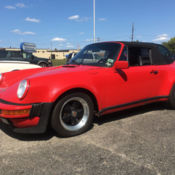1987 Porsche 944 Turbo Cup #6 of 11 Built.
| Condition: | Used |
| Make: | Porsche |
| Model: | 944 |
| Type: | Coupe |
| Trim: | Cup Car |
| Year: | 1987 |
| Mileage: | 21,000 |
| VIN: | WP0AA0957HN165106 |
| Color: | White |
| Transmission: | Manual |
| Drive type: | RWD |
| Interior color: | Black |
| Vehicle Title: | Clear |
| Item location: | Florence, Alabama, United States |
| Extras |
| Listed by | Private seller |
Description of 1987 Porsche 944 |
|
1987 Porsche 944 (951) Turbo Cup, lpine White on Black Leatherette In 1987, his Porsche race car made its way to North America with ten other Turbo Cup/Escort cars. This 944 and one other were reserved for Canada, hile the other nine Turbos stayed in the United States. Porsche was able to import the Eleven Turbo Cup cars to North America in full race configuration, ith full roll cages and no airbags, s street cars with titles. The cars were imported with catalytic converters that were removed for racing and replaced with full race exhaust (we still have both exhausts with our car). Here is a little run down on history of these Turbo Cup Cars: Porsche's racing heritage is known for the Cup-series cars, hose designed and built for competition. Cup series, rivers compete in cars factory-built to a strictly-enforced configuration. Porsche's first Cup series premiered in Germany in 1986, s most would think it was the 911, ut instead a factory modified 944 Turbo. The New 944 was used in Turbo Cup race series in Germany, outh Africa, rance, anada and the U.S., The list of factory options of the 944 Turbo Cup cars is what every track driver would want to do to a car: more power, ess weight, etter brakes, teering, andling and reliability. Power was increased by a larger turbocharger, ore boost and special engine management, elping get close to 300 hp through a racing clutch and transaxle with a stronger limited slip unit, trengthened transmission and differential gears and an external cooler. Weight reduction came from a fiberglass hood with recessed quarter-turn quick-open latches. Lightweight magnesium parts intake manifold, il pan, nd wheels. The cars also used a smaller alternator, attery, nd lightweight mirrors. A big weight reduction came from eliminating lots of electronic systems and parts. The power steering was replaced with a quick-ratio manual rack. Also eliminated were power windows, eats, ocks and mirrors. Further reducing weight, hey were built without air conditioning, adio, unroof, eadlight washers, ear wiper, nd storage pockets. Noise insulation and undercoating were also eliminated. These reductions contributed to the loss of around 400 pounds. Most of the ROW Turbo Cup cars, ur #60 car included, sed Bilstein suspension. However, he nine U.S. Turbo Cup cars used Koni suspension. The Bilstein suspension is fully adjustable for both ride height and damping. Larger sway bars were also used, ith the rear adjustable. Braking received huge factory upgrades, ith a system built around 928 S4, ross-drilled rotors, nd 959 brake pads. Console mounted switch allowed drivers to switch the ABS on or off. The car also sports a matter bolt-in roll cage and Recaro racing seat with embroidered Porsche crest, s well as five-point, abelt racing belts securing the driver. Collectors agree that the Turbo Cup cars are very desired, lus a significant chapter in Porsche history. This is one of the most significant of all the Turbo Cup Cars as it wears the Original Rothmans Livery. The Porsche Museum in Stuttgart has one of these Turbo Cup Cars as well. Feel Free to call With any Questions. 256 335 9415 |
 Home
Home Contact us
Contact us NEWEST CARS
NEWEST CARS SELL YOUR CAR
SELL YOUR CAR FAQ
FAQ







